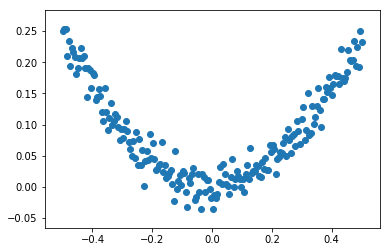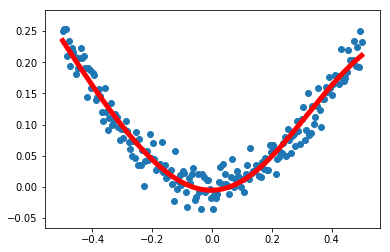import tensorflow as tf import numpy as np import matplotlib.pyplot as plt
# numpy生成200个随机点 x_data = np.linspace(-0.5,0.5,200)[:,np.newaxis] noise = np.random.normal(0,0.02,x_data.shape) y_data = np.square(x_data) + noise plt.scatter(x_data, y_data) plt.show()

# 定义两个placeholder x = tf.placeholder(tf.float32,[None,1]) y = tf.placeholder(tf.float32,[None,1]) # 神经网络结构:1-30-1 w1 = tf.Variable(tf.random_normal([1,30])) b1 = tf.Variable(tf.zeros([30])) wx_plus_b_1 = tf.matmul(x,w1) + b1 l1 = tf.nn.tanh(wx_plus_b_1) w2 = tf.Variable(tf.random_normal([30,1])) b2 = tf.Variable(tf.zeros([1])) wx_plus_b_2 = tf.matmul(l1,w2) + b2 prediction = tf.nn.tanh(wx_plus_b_2) # 二次代价函数 loss = tf.losses.mean_squared_error(y,prediction) # 使用梯度下降法最小化loss train = tf.train.GradientDescentOptimizer(0.1).minimize(loss) with tf.Session() as sess: # 变量初始化 sess.run(tf.global_variables_initializer()) for _ in range(3000): sess.run(train,feed_dict={x:x_data,y:y_data}) # 获得预测值 prediction_value = sess.run(prediction,feed_dict={x:x_data}) # 画图 plt.scatter(x_data, y_data) plt.plot(x_data, prediction_value, 'r-', lw=5) plt.show()
